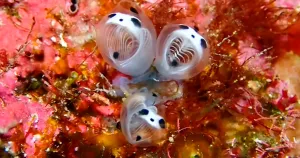Discovery of New Animal Species Opens Doors for Further Studies
Japanese scientists observed a peculiar-looking animal near Okinawa Island, in the Pacific Ocean, and, after a thorough analysis of its characteristics, the researchers discovered that it was a new species, which was named “skeleton panda”. sea” due to its peculiar physical attributes. Tito Lotufo, professor at the Oceanographic Institute of the University of São Paulo (USP), explains the classification of the animal and how its discovery occurred.
New Ascidian
According to the expert, the story of this animal became known after a group of divers observed the species at a diving point in the Pacific Ocean and posted images on social media trying to find out what it was. Because it was unknown until then, no one could recognize the animal and, therefore, some Japanese scientists began to study it to describe its classification.
The professor says that, after collecting the animal from the bottom of the sea, scientists came to the conclusion that the sea panda is a new species of Ascidian, a class belonging to the Tunicate subphylum. This subphylum, according to him, is made up of invertebrate animals, but which, among this designation, are the closest phylogenetically to vertebrate species as they belong to the same phylum, Chordata.
“They are a group of invertebrate animals, but among the invertebrates, they are those closest phylogenetically to us, the vertebrates. They are in the same phylum as humans, the Chordata , so they are called chordates. However, they have an extremely simplified body and live fixed to the bottom of the sea, filtering the water and feeding in this way,” he explains.
Cataloging new species
According to the professor, the designation of names for new species is governed by a set of rules that are part of the International Code of Zoological Nomenclature. He informs that the classification of species is done using the binomial system, that is, it is composed of two words: a genus, written with a capital letter, and an epithet, written with a lowercase letter, which together form the scientific name which, in this case of the sea panda, it was described as Clavelina ossipandae .
According to Lotufo, from the moment a researcher comes across material that cannot fit into any of the species already described, he makes the decision to describe it as a new species. The first step is to report a detailed description, justifying the characteristics of the animal and the reasons why it has to be included in a new species.
The specialist explains that the work is published in a scientific magazine or newspaper so that other specialists can analyze the justifications. “This work, once submitted, is evaluated by those in the field who will verify whether it really is a description that represents a new species. If it is convincing, the work is published and distributed to a certain number of organizations and then the name becomes valid”, he reports.
Study process
According to the professor, the characterization and classification of a new species, in addition to its genetic description, are just the initial steps in the study process. He explains that the work of the taxonomist, the professional responsible for identifying and describing new animals, ends after this primary analysis and, after that, a huge variety of new possibilities open up to be researched and studied.
“Researchers can now open up a range of other possibilities. Does this Ascidian produce any interesting compounds that could have biomedical applications? Does that organism have a relevant role in the functioning of that ecosystem? So none of this has yet been solved, there is still a lot to be done”, he explains.
Marine conservation
According to Tito Lotufo, most of our planet’s environments play an important role in maintaining life on Earth and the oceans, in particular, are a major regulator of the world’s climate. In this sense, for these systems to continue performing their normal functions and offering ecosystem services correctly, they must be functioning properly in their natural balance.
The professor says that, when human beings have an impact on the environment, extinguishing species, polluting the environment, destroying and warming the planet, they are changing the normal configuration of how an ecosystem functions. This process, he explains, impacts the very services that those systems offer to the human population. “Biodiversity is not simply existing there, it is interacting with the environment and with other species. All species have a certain ecological role, so who are we to say who should or shouldn’t exist?”, he concludes.

